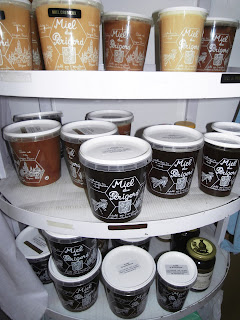The sign outside M. Dufour's home in St Martin de Ribérac
Looking in our larder and seeing it almost naked of honey, yesterday Lesley and I decided it was time for one of our regular visits to the honeyman of St Martin de Ribérac. St Martin is but a short walk heading due south out of town. The church here, which naturally enough dominates, is one of three that form a triangle around the town of Ribérac. The other two are in the villages of Faye, to the north-west and St Martial de Ribérac to the east. I have been reliably informed that all these communes existed before the town of Ribérac. Ribérac now forms the centre of that triangle. Anyway I digress. We arrived at Monsieur et Madame Dufours' just before midday. We were ushered into the inner sanctum of the Monsieur's atelier. We found ourselves surrounded by all things honey. There were jars of propolis, hydromel, which I think is somewhat like English mead and of course pots and pots of honey of all shades and tints. The first thing that strikes you is how clean and well attended everything is, for M. Dufour is a very orderly and correct man.
Any colour, texture or taste you like - A selection of M. Dufour's fine honeys
We were offered miel du fôret, miel de printemps, toutes fleurs and also acacia, which is my particular favourite. I asked M. Dufour how he had been faring this year against the onslaught of Asiatic hornets and their European counterparts. He replied that it had been much better than the previous year and that none of his ruches (hives) had been lost. M. Dufour has 15 hives at St Martin, another 15 at St Sulpice de Roumagnac and a few more just outside Perigueux. The ones in Perigueux are run with a friend and only produce the acacia honey. He had shown me on a previous visit the system he has put in place in order to deter hornet attack on his hives on which he has reduced the size of the flight holes in and out. Previously they had been much bigger, thus allowing the larger hornets access into the heart of the hive. The fascia now adorning the hives has much smaller holes allowing only the bees entry and exit and preventing the hornets entry. He said it was the habit of the Asiatic hornets to hover, motionless, outside the hives (his description was "comme un helicopter") awaiting the exit of the honeybees when they could be picked off one by one.
The honeyman, confident in his product (along with a little help from the bees)
But, now it seems that nature is fighting back and trying to restore some kind of balance in favour of our dear old honey bees. M. Dufour reported that he had heard reports of nids (hornet nests) being attacked by 'mesanges' (woodpeckers) in the very early hours of the morning. Apparently it is when the hornets are at their most slothsome, particularly in these very cold temperatures and it is whilst they are in this state that they become easy prey to the birds.
Happy honey faces!
I suppose to Woody, hanging upside down off the base of a nid (this is where the nest is at its weakest and most vulnerable) high up in the treetops tapping away madly, the hornet larvae seem like easy pickings, certainly compared to the relatively hard wood of a tree. So fingers crossed for our friends in the woods and long may they continue in their magical work,. Perhaps nature has found its own solution to this problem which has decimated many hives in the Aquitaine these past few years.
M. Dufour at work amongst his hives
A hive showing the newly adapted flight holes - good for bees bad for hornets






No comments:
Post a Comment